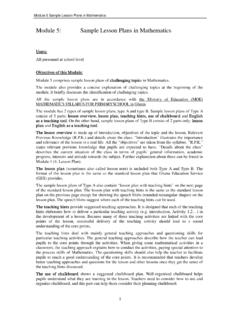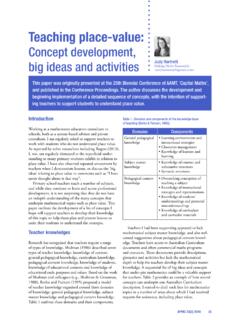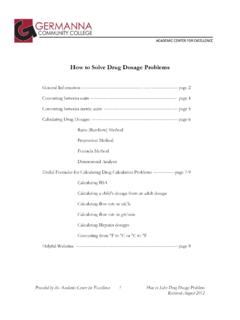Transcription of Practice and Homework Book - MS. TRACY BEHL 4A
1 Practice and Homework Book Authors Peggy Morrow Maggie Martin Connell Publisher Elementary Math Team Leader Claire Burnett Diane Wyman Publishing Team Product Manager Lesley Haynes Kathleen Crosbie Enid Haley Ioana Gagea Lynne Gulliver Stephanie Cox Judy Wilson Design Word & Image Design Studio Inc. Typesetting Computer Composition of Canada Inc. Copyright 2008 Pearson Education Canada, a division of Pearson Canada Inc. All Rights Reserved. This publication is protected by copyright, and permission should be obtained from the publisher prior to any prohibited reproduction, storage in a retrieval system, or transmission in any form or by any means, electronic, mechanical, photocopying, recording, or likewise. For information regarding permission, write to the Permissions Department. ISBN-13: 978-0-321-43803-4. ISBN-10: 0-321-43803-5. Printed and bound in Canada.
2 3 4 5 -- WC -- 11 10 09 08. Contents UNIT Patterns and Equations .. Lesson 1 Patterns in Charts 2. 1 Lesson 2 Extending Number Patterns 4. Lesson 3 Representing Patterns 6. Lesson 4 Equations Involving Addition and Subtraction 8. Lesson 5 Equations Involving Multiplication and Division 10. UNIT Whole Numbers .. Lesson 1 Whole Numbers to 10 000 12. 2 Lesson 2 Comparing and Ordering Numbers 14. Lesson 3 Sorting Numbers 16. Lesson 4 Estimating Sums 18. Lesson 5 Using Mental Math to Add 20. Lesson 6 Adding 3-Digit Numbers 22. Lesson 7 Adding 4-Digit Numbers 24. Lesson 8 Estimating Differences 26. Lesson 9 Using Mental Math to Subtract 28. Lesson 10 Subtracting 3-Digit Numbers 30. Lesson 12 Subtracting 4-Digit Numbers 32. Lesson 13 Solving Addition and Subtraction Problems 34. UNIT Multiplication and Division Facts .. Lesson 1 Using Doubles to Multiply 36.
3 3 Lesson 2 Multiplying by 1, by 0, and by 10 38. Lesson 3 Using Skip Counting to Multiply 40. Lesson 4 Other Strategies for Multiplying 42. Lesson 5 Using Patterns in a Multiplication Chart 44. Lesson 7 Using Arrays to Divide 46. Lesson 8 relating Multiplication to Division 48. Lesson 9 Dividing by Numbers from 1 to 9 50. Lesson 10 Pose and Solve Problems 52. iii UNIT Measurement.. Lesson 1 Calendar Time 54. 4 Lesson 2 Exploring Time 56. Lesson 3 Telling Time 58. Lesson 4 Elapsed Time 60. Lesson 5 Telling Time to the Minute 62. Lesson 6 The 24-Hour Clock 64. Lesson 7 Covering Shapes 66. Lesson 8 Exploring Area 68. Lesson 9 Measuring Area in Square Centimetres 70. Lesson 10 Estimating and Measuring Area 72. Lesson 11 Finding Area in Square Metres 74. Lesson 13 Exploring Rectangles with Equal Areas 76. UNIT Fractions and Decimals .. Lesson 1 Fractions of a Whole 78.
4 5 Lesson 2 Fraction Benchmarks 80. Lesson 3 Exploring Fractions of a Set 82. Lesson 4 Finding a Fraction of a Set 84. Lesson 5 relating Fractional Parts of Different Wholes and Sets 86. Lesson 7 Comparing and Ordering Unit Fractions 88. Lesson 8 Comparing and Ordering Fractions with the Same Numerator or Denominator 90. Lesson 9 Exploring tenths 92. Lesson 10 Exploring hundredths 94. Lesson 11 Equivalent Decimals 96. Lesson 12 Adding Decimals to tenths 98. Lesson 13 Subtracting Decimals to tenths 100. Lesson 14 Adding and Subtracting Decimals to hundredths 102. UNIT Geometry .. Lesson 1 Objects in Our World 104. 6 Lesson 2 Constructing Prisms 106. Lesson 3 Exploring Nets 108. Lesson 5 Symmetrical Shapes 110. Lesson 6 Line Symmetry 112. Lesson 7 Sorting by Lines of Symmetry 114. iv UNIT Data Analysis .. Lesson 1 Reading Pictographs and Bar Graphs 116. 7 Lesson 2 Drawing Pictographs 118.
5 Lesson 3 Drawing Bar Graphs 120. Lesson 4 Comparing Pictographs and Bar Graphs 122. UNIT Multiplying and Dividing Larger Numbers .. Lesson 1 Exploring Multiplication Patterns 124. 8 Lesson 2 Estimating Products 126. Lesson 3 Using Models to Multiply 128. Lesson 5 Other Strategies for Multiplication 130. Lesson 6 Using Patterns to Multiply 132. Lesson 7 Multiplying a 3-Digit Number by a 1-Digit Number 134. Lesson 8 Estimating Quotients 136. Lesson 9 Division with Remainders 138. Lesson 10 Using Base Ten Blocks to Divide 140. Lesson 11 Another Strategy for Division 142. Math at Home 145. v To the Teacher This Practice and Homework Book provides reinforcement of the concepts and skills explored in the Pearson Math Makes Sense 4 program. There are two sections in the book. The first section follows the sequence of Math Makes Sense 4 Student Book. It is intended for use throughout the year as you teach the program.
6 A two-page spread supports the content of each core lesson in the Student Book. In each Lesson: The right page is the Quick Review summarizes Homework page, to be the math concepts and completed by the stu- terminology of the dent with the assistance Student Book lesson. of a family member. Try These presents questions the student can use to check under- standing of the math Stretch Your Thinking concepts and skills in presents an extension each lesson. question. Math at Home The second section of the book, on pages 145 to 156, consists of 3 pull-out Math at Home magazines. These fun pages contain intriguing activities, puzzles, rhymes, and games to encourage home involvement. The perforated design lets you remove, fold, and send home this eight-page magazine after the student has completed Units 3, 6, and 8. vi To the Family This book will help your child practise the math concepts and skills that have been explored in the classroom.
7 As you assist your child to complete each page, you have an opportunity to become involved in your child's mathematical learning. The left page of each lesson contains a summary of the main concepts and terminology of the lesson. Use this page with your child to review the work done in class. The right page contains Practice . Here are some ways you can help: With your child, read over the Quick Review. Encourage your child to talk about the content and explain it to you in his or her own words. Read the instructions with (or for) your child to ensure your child understands what to do. Encourage your child to explain his or her thinking. Some of the pages require specific materials. You may wish to gather items such as a centimetre ruler, index cards, a measuring tape, scissors, number cubes labelled 1 to 6, and paper clips. Many of the Practice sections contain games that will also improve your child's math skills.
8 You may have other ideas for activities your child can share with the rest of the class. The Math at Home pull-out pages 145 to 156 provide more fun activities. vii UNIT 1. T. D E N B OO. TU. 1 Patterns Xxx in Charts K. S. LESSO N. At Ho At Sc me Quick Review hoo l Look at this hundred chart. There is a pattern in the circled numbers. The pattern rule is: Start at 3. Count on by 3s. There is a pattern in the positions of the squares with circles. The pattern rule is: The squares with circles lie along every third diagonal. The diagonals go 1 down, 1 left. Try These 1. Look at the squares with circled numbers on this hundred chart. a) Describe the position pattern. _____. _____. b) Write the number pattern. _____. c) Write a pattern rule for the number pattern. _____. _____. d) Circle numbers to complete the pattern on the hundred chart. 2. Practice 1.
9 A) Start at 102. Count on by 2s. 101 102 103 104 105 106 107 108 109 110. Circle these numbers. 111 112 113 114 115 116 117 118 119 120. b) Start at 102. Count on by 5s. 121 122 123 124 125 126 127 128 129 130. Put an X on each number. 131 132 133 134 135 136 137 138 139 140. c) Write the numbers that have both an X and are circled. 141 142 143 144 145 146 147 148 149 150. _____ 151 152 153 154 155 156 157 158 159 160. 161 162 163 164 165 166 167 168 169 170. _____. 171 172 173 174 175 176 177 178 179 180. d) Write the pattern rule for the number pattern in part c. 181 182 183 184 185 186 187 188 189 190. _____ 191 192 193 194 195 196 197 198 199 200. 2. Look at the squares with circled 1 2 3 4 5 6 7. numbers in this multiplication chart. 1 1 2 3 4 5 6 7. a) Write a pattern rule for the 2 2 4 6 8 10 12 14. position pattern. 3 3 6 9 12 15 18 21. _____.
10 4 4 8 12 16 20 24 28. _____. 5 5 10 15 20 25 30 35. _____ 6 6 12 18 24 30 36 42. b) Write a pattern rule for the number 7 7 14 21 28 35 42 49. pattern. _____. _____. Stretch Your Thinking Follow this position rule. Put 1 2 3 4 5 6 7 8 9 10 11 12. an X in the squares on the chart. 13 14 15 16 17 18 19 20 21 22 23 24. The squares with an X lie along 25 26 27 28 29 30 31 32 33 34 35 36. every third diagonal, starting at 37 38 39 40 41 42 43 44 45 46 47 48. the first diagonal. The diagonals go 1 down and 1 right. 3. UNIT 1. TU. T. D E N B OO. Extending Number 2. K. S. Patterns LESSO N. At Ho At Sc me Quick Review hoo l Here is a pattern of squares drawn Square Number of Dots on dot paper. on Perimeter 1 4. 2 8. 3 12. 4 16. 5 20. ^^^^^^^^^^^^^^^^^^^^^^^^^. One pattern rule for the number Another pattern rule for the of dots on the perimeter is: number of dots is: Start at 4.





